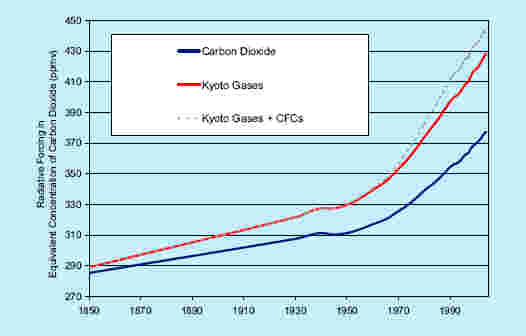|
|||||||||||||||||||||||||||
 Stern
report 2: the ABC
Stern
report 2: the ABC
Posted by James Wimberley
Chapter 1 reviews the basic science. If you have as short attention span as some we won't name, you can squash it into three of Stern's graphs.
A.
The earth is warming
up fast.
Chart page 5, sorry for the poor quality:

The hockey stick is an irrelevance. What does it matter if it was as hot in 1206 as now? We know that 1206 and 2006 both offered liveable climates, unless you live in New Orleans. But they weren't doing anything much in 1206 that could change their global environment for the worse, and we are.
B.
Why? Greenhouse
gases.
Chart page 4:

"The
rising levels of greenhouse gases provide the only plausible
explanation for the
observed trend for at least the past 50 years
.... The causal link between greenhouse gases concentrations and
global temperatures is well established, founded on principles
established by scientists in the nineteenth century." (Stern
p.6)
C.
There's a smoking chimney: fossil
fuels.
Chart p. 175:

Fossil fuels accounted for over 60% of the greenhouse gas emissions in 2000 (p.171). The growth rates in emissions from deforestation and other land use changes were roughly parallel to those in fossil fuels back to 1950, when the data for the former give out.
So much is common ground. Even George Bush accepted the reality of anthropogenic climate change in his Rose Garden speech in June 2001.
What I found most interesting in this part of the Stern report was its discussion on the origin of the science (Wikipedia links added):
Current understanding of the greenhouse effect has its roots in the simple calculations laid out in the nineteenth century by scientists such as Fourier, Tyndall and Arrhenius. Fourier realised in the 1820s that the atmosphere was more permeable to incoming solar radiation than outgoing infrared radiation and therefore trapped heat. Thirty years later, Tyndall identified the types of molecules (known as greenhouse gases), chiefly carbon dioxide and water vapour, which create the heat-trapping effect. Arrhenius took this a step further showing that doubling the concentration of carbon dioxide in the atmosphere would lead to significant changes in surface temperatures.
This underlying physics is rock-solid, unexciting stuff. (You can check out some of it yourself. I've built a toy model that does this, too childish for posting here, so it's tucked away here on my personal website). It doesn't fit the Romantic, Promethean story revived by Thomas Kuhn, of lonely geniuses struggling to overthrow an inferior paradigm embedded in a consensus conventional wisdom. There's no equivalent here to phlogiston, the ether, heliocentrism, or special creation of species, strong explanatory accounts with wide support. It's much more like the Baconian story of electricity: first there wasn't any science, then Ampère, Faraday, Ohm etc. made some observations, and after a bit of to-ing and fro-ing knocked it into a perfectly sound theory. New bits are being added all the time, but there's no fundamental debate as with cosmology or sociobiology.
There's something else.
Climate models use the laws of nature to simulate the radiative balance and flows of energy and materials. These models are vastly different from those generally used in economic analyses, which rely predominantly on curve fitting. (Stern p.8)
Social scientists are used to models where the underlying theory is almost completely qualitative, as with microeconomics, and at best gives you the direction of a causal link. To build a quantitative model, you have to tweak the model parameters till they fit the data. There's no deep reason why the elasticities in an economic model should be what they are. The basic laws in climate models, physical or chemical, are quantitative. Potentially, climate models can be far superior to economic ones, and Stern claims they already are. They are certainly much bigger. I'm one of 60,000 volunteering my PC to a distributed climate simulation; my run will be 1850 hours of CPU time when it's finished, and that's just one run of one component of one model.
Sceptics can't challenge the basic science, as it's secure textbook stuff. But since the interactions are numerous, a climate model gets forbiddingly complex and pushes against the frontiers of computability. The uncertainties arise in the way the models are put together.
In the next post I'll have a look at the controversial science: predictions, sensitivities, and should we give the surviving sceptics air time?
If you found this too elementary, join the discussion at realclimate.org instead. I don't propose to compete with climate scientists.
Posted
at 02:22
PM
| TrackBack
(0) |
![]() |
|
Thread: Climate
change
Post a comment